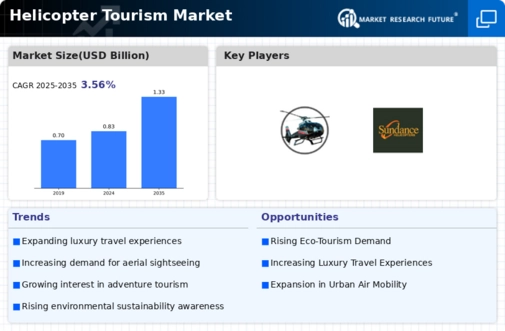Market Share
Helicopter Tourism Market Share Analysis
Collaborative ventures and partnerships present significant opportunities for the commercial aviation industry. As air travel continues to soar, helicopters, akin to airlines, are forging strategic alliances with hospitality service providers like resorts and tourism companies. This collaborative approach serves as a mutually beneficial strategy for helicopters and their partners, creating awareness about their offerings and ultimately maximizing annual revenue.
A prime illustration of this collaborative trend is evident at the Palazzo resort in Las Vegas, which has entered into an agreement with a private helicopter company. This partnership offers hotel guests breathtaking rides in and around the Grand Canyon, enhancing the overall experience. Similarly, Dezaiko Lodge has teamed up with Aberdeen Helicopters, a Canada-based company, providing tourists with helicopter tours of a popular ski destination. Another noteworthy example is the enduring 35-year strategic partnership between Alpine Helicopters, based in Canada, and Canadian Mountain Holidays for conducting tours.
Such strategic collaborations not only benefit tourists by providing convenient and comprehensive services but also significantly boost the revenues of helicopter operators. The increasing prevalence of such partnerships not only augments the financial gains for resorts, hotels, or tourism firms but also expands the scale and influence of the helicopter tourism market.
In the realm of helicopter tourism, a noteworthy evolution has been the emergence of unmanned helicopters. These modern helicopters represent a fusion of innovations and modifications that markedly enhance performance without altering their overall appearance. Unmanned helicopters have become a response to the rapid progress in technology and the escalating demand for helicopter services.
The growth of archaeological tourism globally has faced hindrances due to challenging geographical terrains. Unmanned helicopters have stepped in to address this issue, equipped with a 360˚ panoramic dynamic data acquisition system. This system provides high-quality images and videos of tourist destinations or archaeological sites, overcoming accessibility challenges. Beyond mere convenience, these unmanned helicopters transform the tourism experience for older individuals and those with disabilities.
Moreover, unmanned helicopters serve as potent marketing tools for the tourism industry. They offer tourists innovative video content, showcasing unique perspectives of tourist destinations, resorts, and hotels. Many destinations and resorts are leveraging the capabilities of these helicopters to create captivating videos that highlight their specialties, amenities, offerings, and surrounding attractions.
In tandem with technological advancements, the integration of big data with helicopters has become a pivotal aspect. When opting for helicopter tours, passengers rely on helicopters to navigate harsh environments and ensure safe travel. Big data analysis tools enable the comprehensive monitoring of an entire helicopter fleet, identifying potential safety risks and ensuring a secure journey for passengers.
In conclusion, the collaborative trend in the aviation industry, especially within helicopter tourism, underscores the industry's adaptability and responsiveness to evolving consumer demands. The emergence of unmanned helicopters and the integration of big data highlight the industry's commitment to innovation and safety. As these trends continue to shape the helicopter tourism landscape, the industry is well-positioned to offer enhanced and diversified experiences for travelers worldwide.





Leave a Comment